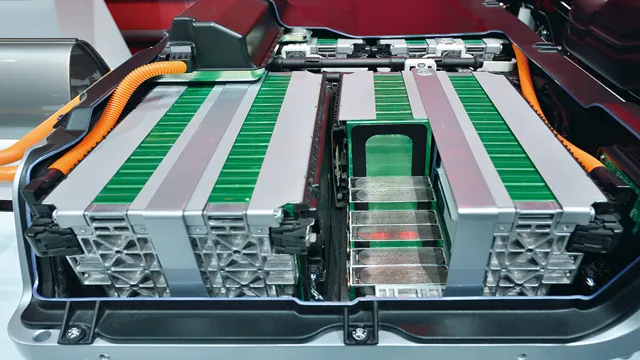Breaking the limits: Understanding the electrifying constraints of electric car batteries
Electric cars are becoming increasingly popular as more people demand cleaner and greener modes of transportation. Electric cars are environmentally friendly, quiet, and offer excellent acceleration. However, the biggest hurdle for electric cars is their battery limitations.
As much as they are a game-changer, electric car batteries are not made equal and come with some limitations. In this article, we’ll delve deeper into the challenges that electric car batteries present and how companies are looking to overcome them. What are the most significant limitations of electric car batteries, and how can they be improved? Let’s find out together.
Overview of Electric Cars
Electric cars are becoming increasingly popular due to their environmentally-friendly and cost-effective benefits. However, one major limitation is their battery life and charging time. While modern electric cars can travel impressive distances on a single charge, typically between 100-300 miles, this is still significantly less than traditional gasoline vehicles.
Additionally, recharging an electric car can take much longer than simply refilling a gas tank, typically taking hours to fully charge. This can be inconvenient, especially for long-distance driving or when there are limited charging stations available. However, as technology continues to improve, researchers are working towards developing faster charging times and lightweight batteries with longer lifespans, which may help overcome these limitations.
Overall, while electric cars may have some limitations, they provide a promising alternative to traditional gasoline vehicles and are paving the way towards a cleaner, more sustainable future.
How Electric Cars Work
Electric cars are becoming increasingly popular, and for a good reason. They’re environmentally friendly, quieter than traditional vehicles, and require less maintenance. Instead of relying on gasoline, electric cars use a rechargeable battery to power an electric motor, which drives the wheels.
This makes them incredibly energy efficient, as most of the energy from the battery goes directly to the motor. Plus, when it comes to charging, electric cars can be plugged into any standard outlet or specialized EV charger. One of the most significant benefits of electric cars is that they emit zero emissions while driving, making them a smarter and more responsible choice for the environment.
As more and more people switch to electric cars, the future of transportation looks brighter and more sustainable.
Types of Electric Cars
Electric Cars Electric cars are vehicles that are powered by an electric motor rather than a traditional gasoline engine. There are three primary types of electric cars: battery electric vehicles (BEVs), plug-in hybrid electric vehicles (PHEVs), and hybrid electric vehicles (HEVs). BEVs rely solely on electricity to power the motor, while PHEVs have a combination of electric and gas power and can recharge through an external power source.
HEVs use both electric and gas power but do not have the ability to recharge externally. Depending on your driving habits and needs, one type of electric car may be more suitable for you than others. With advancements in technology and increased demand for sustainable transportation options, electric cars have become a popular choice for environmentally conscious consumers.
The benefits of electric cars include lower emissions, cheaper fuel costs, and a quieter driving experience. However, there are also some drawbacks such as limited range and longer charging times compared to filling up gas. Nonetheless, owning an electric car is a great step towards reducing your carbon footprint and contributing to a greener future.
Battery Limitations
Electric car battery limitations have been a big concern for many car buyers who are looking for alternatives to gas-powered vehicles. Although electric cars are great for the environment, they are not perfect. The most considerable problem is the range of the battery.
While most electric cars have a range of around 200-300 miles, this is still less than what most gas-powered vehicles can achieve. This means that electric car drivers have to plan their routes carefully, and charging stations are not as abundant as gas stations. Additionally, cold weather can cause the battery to drain faster, and hot weather can reduce the battery’s lifespan.
These are all issues that car manufacturers are working to overcome, but they are still limitations that need to be addressed. However, it is important to remember that we are still in the early days of electric car production, and advancements are being made all the time.
Battery Range
Battery range is a big issue when it comes to electric vehicles. No matter how advanced the technology gets, battery limitations are still present. One major limitation is the distance a vehicle can cover on a single charge.
This distance can vary significantly depending on various factors such as driving style, weather conditions, terrain, and the size of the battery. For instance, if you drive in a hilly area, your EV will consume more energy, and its range will decrease. Similarly, if it’s freezing outside, the battery’s performance will be affected, and you’ll get less driving range.
Moreover, electric cars tend to experience a phenomenon known as “range anxiety,” which is the fear of running out of charge before reaching your destination. However, many automakers are working to increase the range of their EVs using improved battery technology, which could eliminate these limitations. But until then, it’s essential to plan your route and driving behavior to get the most out of your EV.
Charging Time
Charging time is a major factor to consider when it comes to battery limitations. While modern charging technology has come a long way, it still takes time to charge our devices. This can be frustrating, especially if you’re in a hurry and need to use your device right away.
However, it’s important to understand that there are limits to how fast we can charge our batteries, and pushing those limits can have negative consequences for the battery’s lifespan. Think of a battery like a water tank. If you pour too much water in too quickly, it will overflow and potentially cause damage.
Similarly, if we try to charge a battery too quickly, it can overheat and potentially become damaged. This is why manufacturers often cap the charging speed of their devices, to ensure that the battery remains safe and healthy. It’s also important to note that not all batteries are created equal.
Different types of batteries have different limitations when it comes to charging time. For example, some types of batteries can take longer to charge but can hold more energy, while others charge more quickly but don’t hold as much energy. It’s important to understand the specific limitations of your device’s battery, so you can make the most of its charging time without damaging it.
Ultimately, while charging time can be frustrating, it’s important to remember that it’s a necessary aspect of battery life. By being patient and understanding the limitations of our batteries, we can maximize their lifespan and ensure that they continue to work properly over time.
Battery Degradation
Battery degradation is an inherent limitation in all batteries, including those used in electric vehicles (EVs). Over time and with repeated charges, the battery’s ability to hold a charge gradually reduces, leading to a shorter driving range. The severity of battery degradation varies depending on different factors such as driving habits, temperature, and the frequency of charging and discharging cycles.
Some EV manufacturers use sophisticated battery management systems that can mitigate the effects of battery degradation to some extent. However, it is crucial for EV owners to properly maintain and manage their batteries to maximize their lifespan and minimize degradation. This includes avoiding exposing the battery to extreme temperatures for extended periods, avoiding frequent fast charging, and charging the battery to less than 100% to reduce stress on the battery.
By taking care of their EV batteries, owners can ensure that they get the most out of their electric vehicles while minimizing the impact of battery limitations.
Factors Affecting Battery Performance
Electric car battery limitations are a crucial factor to consider when purchasing an electric car. While electric cars are seen as a green and environmentally friendly option, the battery’s limitations are one of the main issues that owners face. The range offered by electric cars is determined by the battery’s capacity, which means that the bigger the battery, the further you can go.
However, larger batteries come at a higher cost, and their size makes them bulkier and heavier, which can negatively impact the vehicle’s performance. Moreover, factors such as temperature and terrain can also affect a battery’s range and performance. For example, colder temperatures can reduce a battery’s capacity, and driving uphill can drain the battery faster than driving on a flat surface.
Despite the limitations, advancements in battery technology are continuously being made, allowing for higher energy densities and longer ranges, making electric cars a more viable option for drivers looking to switch to a greener option.
Temperature
Temperature Temperature is one of the most important factors that affects the performance and lifespan of batteries. High operating temperatures can significantly reduce battery life, whereas lower operating temperatures generally improve battery performance. This is because temperature affects the rate of chemical reactions inside the battery that produce electricity.
At high temperatures, these reactions accelerate, which can cause the battery to lose capacity and eventually fail. Conversely, colder temperatures cause the reactions to slow down, which can reduce the battery’s overall performance. To optimize battery performance, it is important to avoid exposing batteries to extreme temperatures.
When using and storing batteries, it is important to keep them in a cool, dry place and avoid exposing them to direct sunlight or other sources of heat. By taking proper care of batteries and monitoring their temperature, you can help extend their lifespan and ensure they perform at their best.
Driving Habits
Driving Habits Taking good care of your car battery is crucial to ensure it performs well and lasts longer. But did you know that your driving habits can greatly influence the performance of your battery? One significant factor that affects battery health is the frequency and duration of your trips. Short trips, especially in cold weather, cause your battery to work harder, reducing its lifespan.
Similarly, if your vehicle sits unused for long periods, its battery may become discharged and eventually fail. Also, heavy acceleration, abrupt braking, and high-speed driving can put a significant strain on your battery and reduce its efficiency. Therefore, it is essential to maintain your vehicle’s battery by driving regularly, avoiding frequent short trips, and driving smoothly and at moderate speeds.
Following these simple driving habits will help your battery stay healthy and extend its lifespan.
Solutions to Battery Limitations
Electric car battery limitations can be a hindrance to the widespread adoption of electric vehicles. However, there are several solutions that can help mitigate the limitations and improve the overall performance of electric car batteries. One solution is to improve the battery technology itself, such as by increasing the density of the battery cells or developing new materials that can boost battery storage capacity.
Another solution is to optimize the way electric cars are recharged, such as by introducing fast-charging stations or implementing smart charging systems that can balance demand on the grid. Additionally, utilizing renewable energy sources, such as solar or wind, to power electric car charging can further reduce the environmental impact of electric cars and increase their overall sustainability. By implementing these solutions, electric car batteries can become more efficient, convenient, and environmentally-friendly.
Conclusion
In the world of electric cars, batteries are the heart and soul of the vehicle. However, like all hearts, they have their limitations. While electric car batteries have come a long way, they still have some way to go to fully replace traditional gasoline engines.
But fear not – the battle for electric car batteries continues to rage on. With innovations and advancements constantly being made, we can be confident that the day when electric car batteries are able to match and surpass their gas-guzzling counterparts is not too far away. So, for now, let’s enjoy the fact that we have a cleaner, more sustainable alternative to traditional cars – battery limitations and all!”
FAQs
What is the range limit of an electric car battery?
The range limit of an electric car battery depends on several factors, such as the size of the battery, driving conditions, and weather. However, most electric cars can typically travel 100-250 miles on a single charge.
How long does it take to charge an electric car battery?
The charging time of an electric car battery depends on the type of charger and the size of the battery. Typically, it can take anywhere from 30 minutes to several hours to fully charge an electric car battery.
Can an electric car battery be replaced or upgraded?
Yes, an electric car battery can be replaced or upgraded, just like a regular car battery. However, it can be an expensive process that depends on the make and model of the car.
What are the environmental impacts of manufacturing and disposing of electric car batteries?
The manufacturing and disposing of electric car batteries can have negative environmental impacts, such as the mining of raw materials and the disposal of toxic waste. However, electric cars still have a lower carbon footprint over their lifetime compared to gasoline-powered cars.






